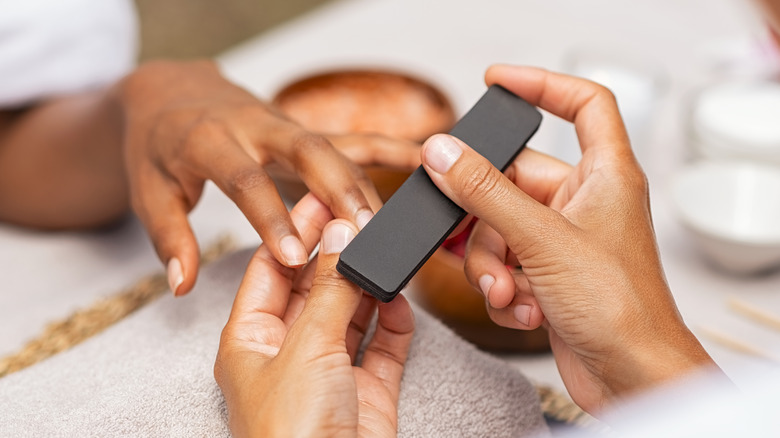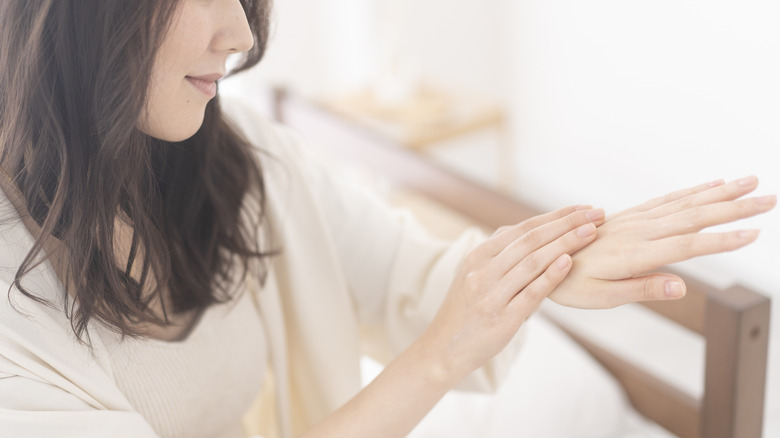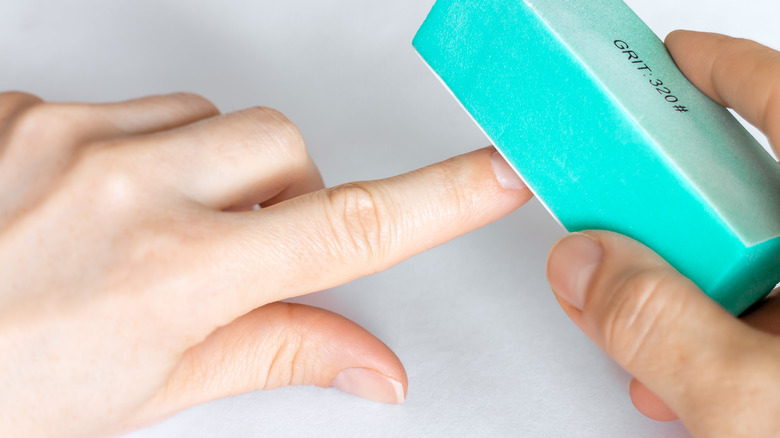How Often Should You Really Buff Your Nails?
Nail enthusiasts know that the path to a pristine manicure isn't just about applying polish or affixing press-ons. The process takes a lot of small steps toward perfection, from cleaning and shaping to a good old-fashioned buffing. In fact, we'd argue that buffing is one of the unsung heroes of gorgeous and healthy nails — no matter what kind of mani you prefer.
Left untended, our nails can take on a bit of a rough-and-tumble look. They may be prone to peeling, develop uneven texture, or even hold onto stains from past polishes. This is where buffing comes in, ready to gently remove imperfections and leave behind a smooth, clean slate for your next adventure in nail art. As with any self-care practice, though, you may not want to charge in willy-nilly. When it comes to a nail routine that's both safe and effective, when you buff can be just as important as how you buff. It's generally recommended to buff between once a week and once a month, depending on your nail goals and the specific tool you're using.
Buffing is one the best ways to get rid of fingernail ridges, not to mention giving your nails a lovely, satiny finish that can stand on its own. If you don't want to put a whole new manicure on top, buffed nails look super elegant just with a touch of clear polish or trendy, barely-there nail brightener.
Your buffing schedule should strike a happy medium
For many of us, our beauty routines are complex and varied. Some tasks are undertaken daily, others weekly, and yet others may only need attention after weeks or months. While you don't want to neglect your nails and leave them looking dull, it turns out that there is such a thing as buffing too much. Just like you wouldn't want to over-exfoliate your skin, you don't want to over-buff your nails.
The key, as with most things, is to find that "just right" regularity. "I think that buffing is great as long as you don't do it more than once a week," manicurist Michelle Saunders revealed, per Harper's Bazaar. This can be part of a larger nail routine — say, applying a new color at home or having them professionally done — or to keep bare nails healthy and glowing for a simple, minimalist look.
But before embarking on a new nail-buffing regimen, consider the tools at your disposal. Softer buffers are gentler and less likely to damage your nails, meaning you can use them a bit more freely. But hardcore buffers — like many used in professional salons — may be designed to tackle the tough surface of acrylic nails. These should only be used on natural nails carefully and occasionally. Rather than once a week, you may want to limit yourself to once a month with these power tools.
How to get the most out of your buffing routine
Depending on your level of nail obsession, you may already have useful tools at hand. But for the sake of argument (and your wallet), let's look at the most accessible buffing method: using a simple, inexpensive block-style buffer.
With a buffer block, buffing your nails at home is super easy. Start by removing any residual nail polish, washing your hands, and drying them thoroughly. Dry nails are important to prevent extra damage or breakage. Use a file to shape your nails as desired, then grab your buffer block, which should offer a few different textures to work with. Start with the coarsest texture, very gently rubbing it over your nails in a side-to-side motion to sand away any noticeable texture. Wipe your nails with a clean cloth or cotton ball, then switch to a less coarse side of your buffer block to polish your nails with the same side-to-side technique. Wipe again, and if there is an even gentler texture on your buffer, finish with that to softly add shine.
It's just that easy! And hot tip: You can also use your nail buffer on shiny nail polish after it dries to easily mimic a matte manicure at home. This doesn't even count toward your once-a-week limit, since the buffer isn't affecting the actual surface of your nail. So have fun, and happy buffing!


